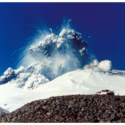Stratovolcanoes are steep-sided, cone-shaped volcanoes. If the magma chamber1 within the volcano grows, the expansion can break the flanks of the volcano and cause it to collapse – creating a landslide. If the volcano is in the ocean – like Te Puia Whakaari/White Island or Indonesia’s Anak Krakatau – the debris can quickly displace/push a large volume2 of water and generate tsunami3 waves.
In this activity, students use a balloon in a container of sand and water to model how volcanic eruptions can generate a tsunami.
By the end of this activity, students should be able to:
- demonstrate how magma chambers expand and the effects this expansion may cause
- demonstrate how a horseshoe-shaped crater is formed by a lateral4 eruption
- demonstrate how tsunami waves are generated by a landslide
- identify Te Puia Whakaari/White Island and Anak Krakatoa volcanoes and tsunamis5 and discuss their formation.
Download the Word file (see link below).
Related content
We have a wide range of related resources curated in these handy introductory articles below:
Researchers discovered that the large underwater Hunga Tonga–Hunga Ha’apai volcano had a hidden caldera6 150 m below the waves. Read about the devastating volcanic eruption in January 2022, the tsunami that followed and what we might expect next. Find out what scientists have discovered a year after this eruption in this article.
Activity idea
The Rotorua geothermal area was formed by a massive caldera. Watch the Rotorua caldera formation animation then go outside and conduct the student activity Calderas in the sandpit.
Useful links
The Volcanic Café website has information on the 2018 Anak Krakatau volcanic eruption. The BBC has before and after photos that demonstrate the striking cone shape prior to the eruption and the horseshoe-shaped caldera after the eruption. This simulation shows the tsunami event that followed.
Acknowledgement
This activity was developed by Kathleen Sibuea, a graduate student at the University of Canterbury. The activity uses a model developed by Dr Graham Leonard, a natural hazard scientist and geologist7 with GNS Science, and Professor Ben Kennedy at the University of Canterbury.
The project received funding from GNS Science Beneath the waves.
- magma chamber: A space under a volcano that stores magma (molten rock) before and between eruptions.
- volume: 1. The quantity of space occupied by a liquid, solid or gas. Common units used to display volume include cubic metres, litres, millilitres, tablespoons and teaspoons. (Volume can refer to a large quanity of something). 2. The degree of sound intensity or audibility; loudness.
- tsunami: A series of massive waves generated in the ocean usually by earthquakes, volcanic eruptions or submarine and coastal landslides, but they can also be caused by the impact of meteorites from outer space.
- lateral: Side.
- tsunami: A series of massive waves generated in the ocean usually by earthquakes, volcanic eruptions or submarine and coastal landslides, but they can also be caused by the impact of meteorites from outer space.
- caldera: When a volcano erupts, a large volume of magma (lava) can spew onto the Earth’s surface. When this large volume of material is removed from beneath the volcano, it can cause it to collapse into the emptied cavern to form a depression. This depression or basin is called a caldera. Some calderas are several kilometres deep and over 25 kilometres wide.
- geologist: Someone who studies the materials and processes that form the Earth. They try to understand how the planet has changed over time.



